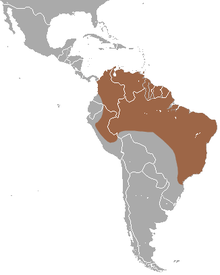Common stub thumb
| Common stub thumb | ||||||||||||
|---|---|---|---|---|---|---|---|---|---|---|---|---|

Common stump thumb ( Furipterus horrens ) |
||||||||||||
| Systematics | ||||||||||||
|
||||||||||||
| Scientific name of the genus | ||||||||||||
| Furipterus | ||||||||||||
| Bonaparte , 1837 | ||||||||||||
| Scientific name of the species | ||||||||||||
| Furipterus horrens | ||||||||||||
| ( F. Cuvier , 1828) |
The common stump thumb ( Furipterus horrens ) is a species of bat in the family of the stump thumb (Furipteridae). It forms the monotypical genus Furipterus . Despite its relatively large range, this bat is considered rare and little explored.
features
With a head-trunk length of 33 to 40 mm, a tail length of 24 to 36 mm, a forearm length of 30 to 40 mm and a weight of about 3 g, the species is smaller than the rocky coast stub thumb ( Amorphochilus schnablii ). Together they are the only representatives of the stubby thumb family. In the common stump thumb, females are significantly larger than males. The fur has a gray-brown to dark gray color on the upper side, usually with a blue shade, while the underside is slightly lighter. On the head, the fur consists of long hair that almost covers the mouth. Hair can also be found on the front and back of the flight membrane .
The German trivial name refers to the rudimentary thumb that is almost completely enclosed in the flight skin. Only a knoll with a claw is visible. The snout of the common stump thumb resembles an upturned pig's trunk. There is no nasal sheet or other bulges on it.
Distribution and way of life
The common stump thumb lives in northern South America east of the Andes. The southern limit of the distribution area extends from Peru via central Brazil to the east of the state of Paraná . A small disjoint population occurs in Costa Rica . The species inhabits rainforests and other humid habitats.
Colonies with up to 60 individuals rest, among other things, in hollowed out trees. In caves, a colony can consist of up to 250 members. It is usually divided into smaller groups of up to 30 individuals. The bats are very shy and prone to disturbance in the resting place. The hunt for butterflies and other insects takes place after dusk near the ground up to a height of 5 meters. The species shows a moth-like flight pattern.
status
The IUCN lists the common stump thumb due to its extensive range as not endangered ( least concern ).
swell
- Ronald M. Nowak: Walker's Mammals of the World. Volume 1. 6th edition. Johns Hopkins University Press, Baltimore MD u. a. 1999, pp. 410-411, ISBN 0-8018-5789-9 .
- Wilson & Reeder (Eds.): Mammal Species of the World . 3. Edition. Johns Hopkins University Press, Baltimore 2005, ISBN 0-8018-8221-4 ( Furipterus -: English untitled .).
- Furipterus horrens in the endangered Red List species the IUCN 2008. Posted by: Miller, B. Reid, F., Arroyo-Cabrales, J., Cuarón, AD & de Grammont, PC, 2008. Accessed June 14, 2016th
